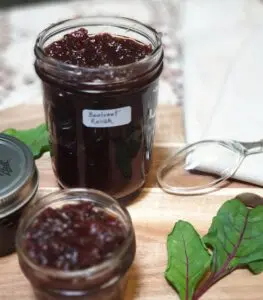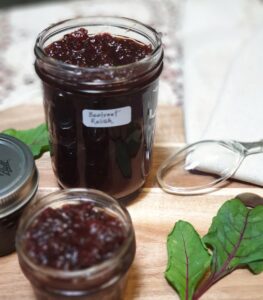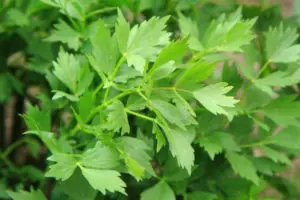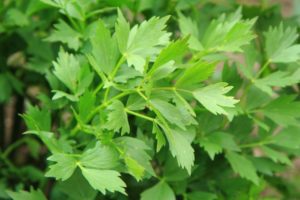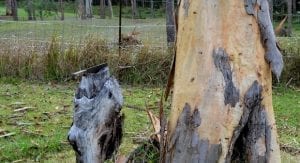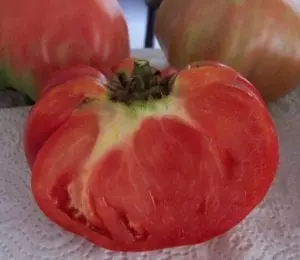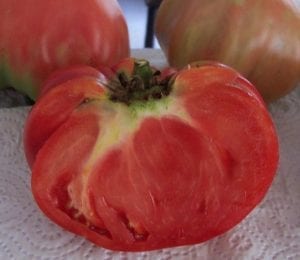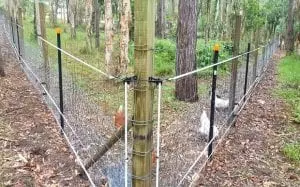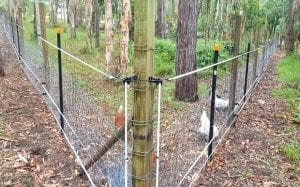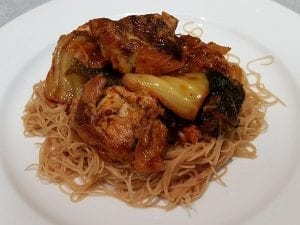Introduction
The following article is a compilation of several smaller posts donated by the Phantom Comentor or PC. This person may prefer to remain unknown; however, as you will discover he has a wealth of self sufficient knowledge to offer us. PC is a very competent vegetable and fruit grower, and is also well versed in bee keeping both native and honey bees.
Do I know PC personally? Yes, but I'm not telling… I'm sure you'll enjoy this unique and diverse post of bees, vegetables, and fruit.
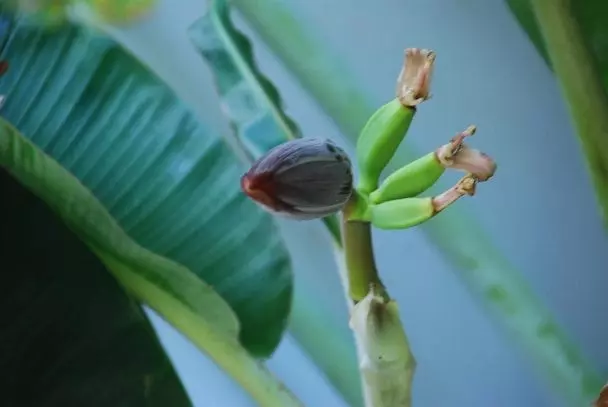
Young banana bunch (image above)
Have finally got a bannana plant to flower (above).
Below: Corn and beans are finishished, but the cucumbers are coming along nicely.

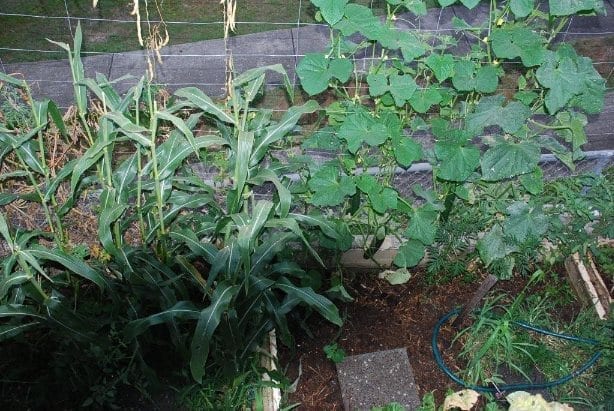
Honey Bees
Replacement queen cells in beehive (below)

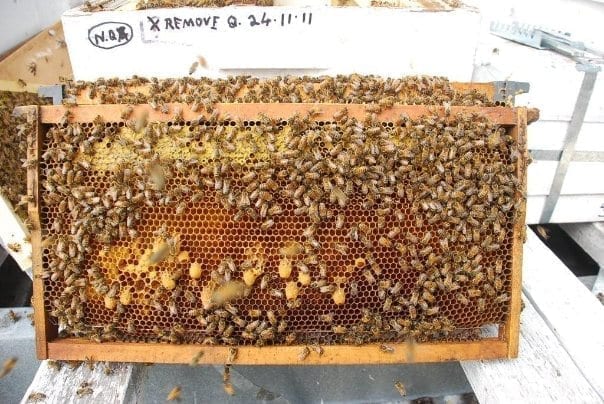
"Its time to requeen the Apis Melitera. When you remove the excisting queen, the workers will make new queen cells out of worker cells. Relacement queen cells are found in the middle of a frame of brood, and swarming queen cells are found at the bottom of the frame."
Australian Native Stingless Bees
“Trigona Carbonaria"

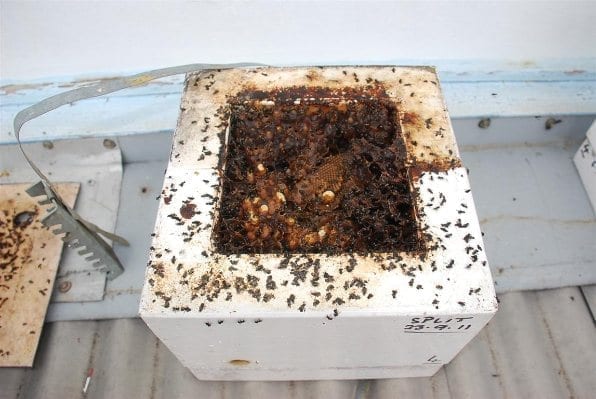
Trigona Carbonaria nest (above) with lid removed, ready to split. By “splitting” a hive in two there is a good chance of the animals making a second nest. A 1 in 5 chance that it won’t work and you will still have one nest, and a small chance that you will end up with no animals. Thats a risk one takes.
Trigona carbonaria hive split in two (image below)

Hive split in two for propagation. Note the honey and pollen stores to the outer, and the brood in the centre. Brood is the young bee nursery.
Corn

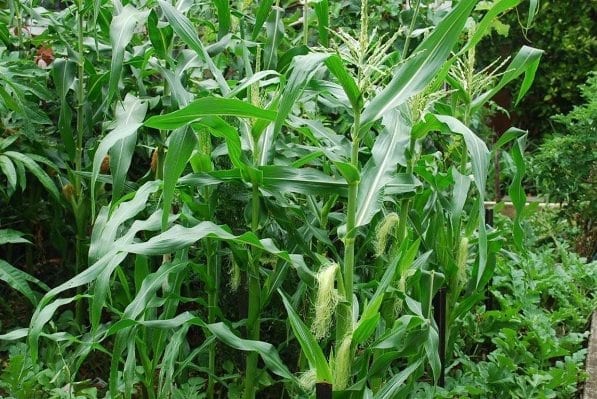
Another two crops of corn. In the background a few cobs ready to pick. In the foreground another few plants flowering.

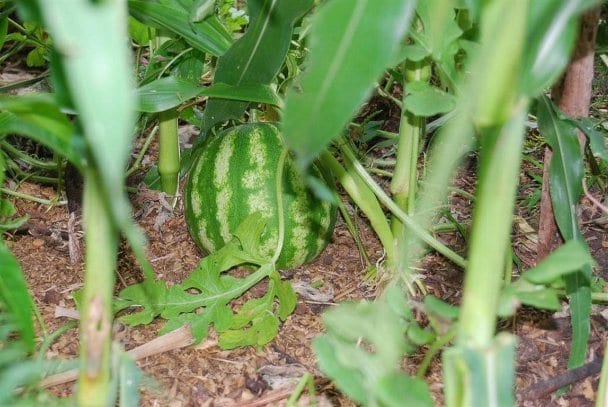
And, in amongst the corn is the first of the melons for the season.
More Bananas
Banana bunch (image below)

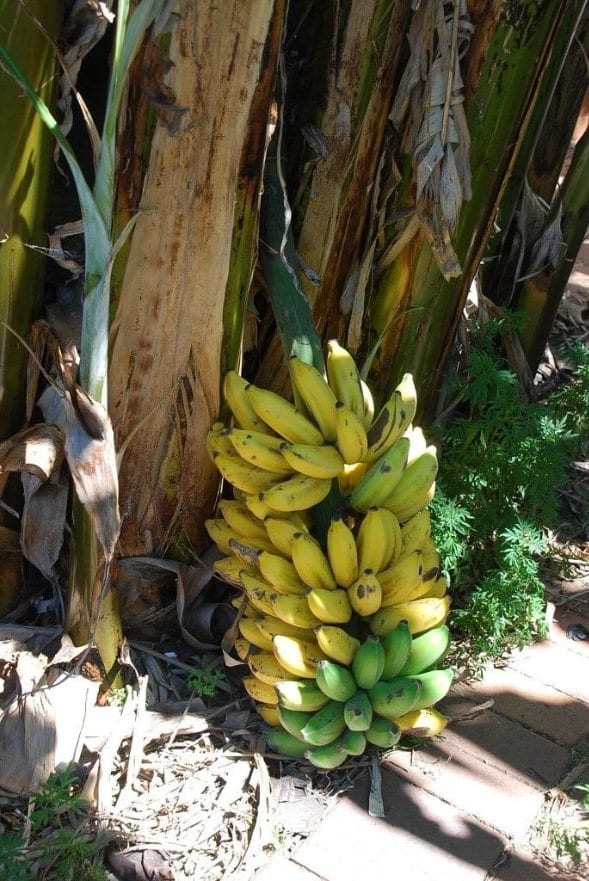
It looks like a naanna diet this week! A chance to catch up on the fibre
intake, and regain a regular pulse.
Rockmelon


Accidents sometimes happen. Cucumber and rockmelon seed are very similar in appearance. Also the leaves are similar. When some bought cucumber seed were planted, one of the plants produced a round "cucumber". Rockies take much longer to mature than cucumbers.
Pineapples (the 10 year wait…)

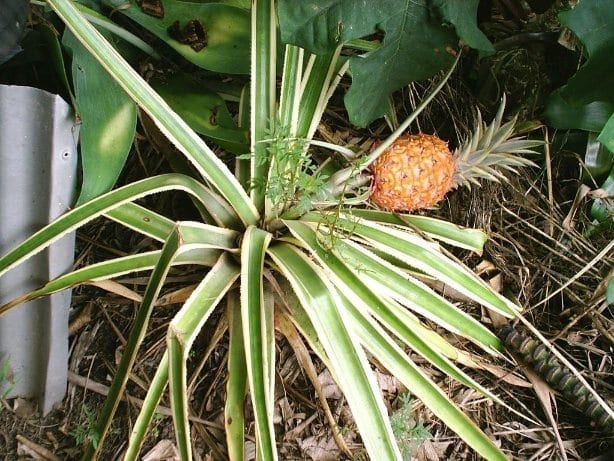
Pineapple Bromeliade plant with fruit (above)
The Bromeliaed family consist of approximately 1,600 varieties, covering a great diversity of plant styles. It is from this family of plants that the commercial pineapple fruit was developed.
This is a Pineapple Bromeliaed plant. Note the red stripes on the leaves. It has taken about 10 years for this plant to bear a flower/seed/fruit. The last one we ate tasted like a regular pineapple that you would buy in a shop. I will plant the top to grow another pineapple in another ten years. The mother plant will produce a couple of pups, and then kick the proverbial bucket!
Tree Tomatoes

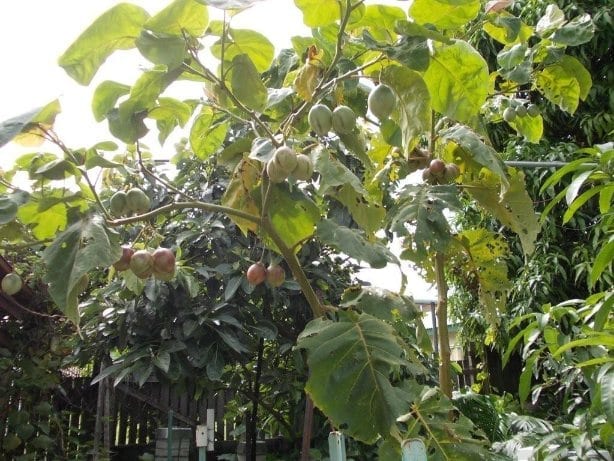
The tree tomatoes are ripening. Rumour has it that the plant was germinated by a bear. (?) Truth or fiction? BELEIVE IT OR NOT!"
Tough losses to animals

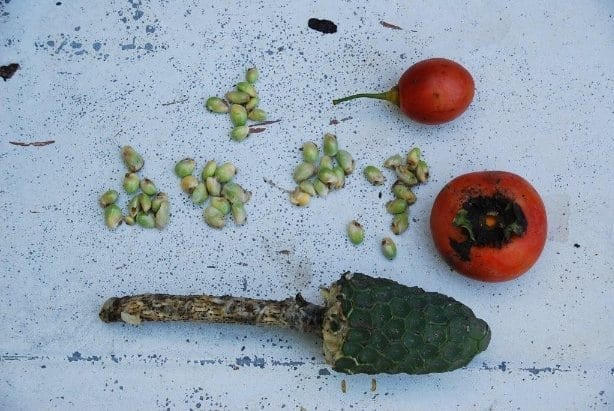
Picked the entire Persimmon crop from two trees today. ONE FRUIT! This one was hidden under a Monstera leaf and the vermin missed it. Also shown in this photo is a part eaten Monstera fruit. Most have no seeds, this one had 48 seed, with probably more in the remainder. The most seed I have previously seen in a Monstera is about half a dozen.
An interesting outcome in the attempt to encourage Carbonaria's to propagate.
I placed a shallow empty box, with entrance, between a lower box of brood and a small part box of stores. Six weeks later I opened hive to find brood in the top box with stores. See photo 1 (below) after lid was removed from three boxes on a 50 mm thick base.

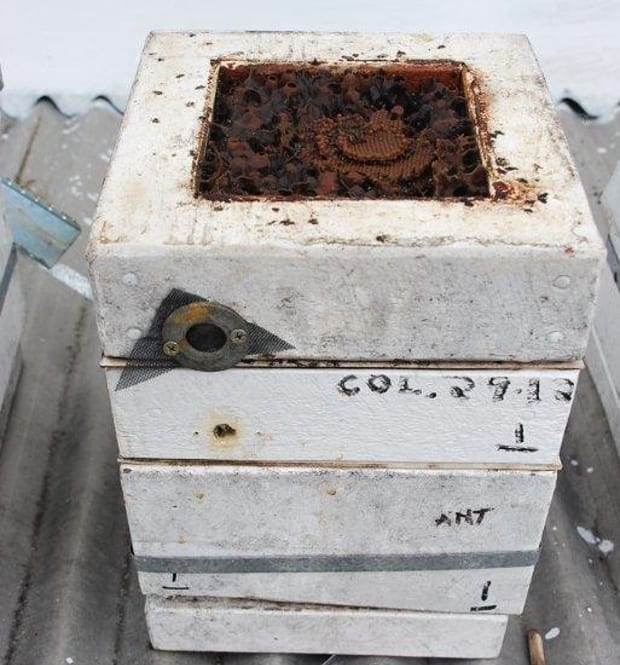




















Second photo (below) shows hive opened and brood also in lower box. That is two nests separated by an empty half size box. The two nests use a common entrance in middle box. At the upper left of the vertical square of vinyl from between boxes, can be seen the 9 mm hole which allows the bees access to the lower box. Between the top box and middle access box is a similar separating sheet. I am now trying to repeat this exercise with half a dozen other hives. Time will tell if propagation of a second colony using this method is repeatable. Cheers, PC

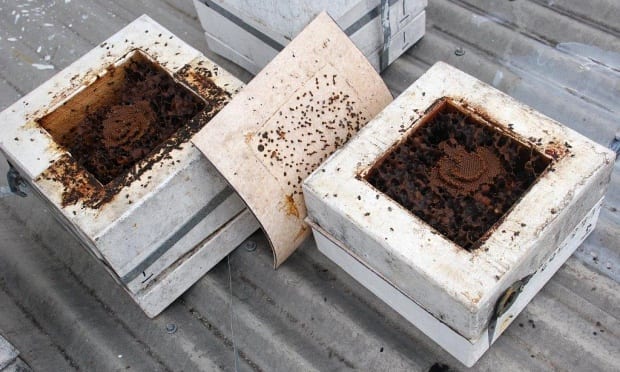
2 months later…

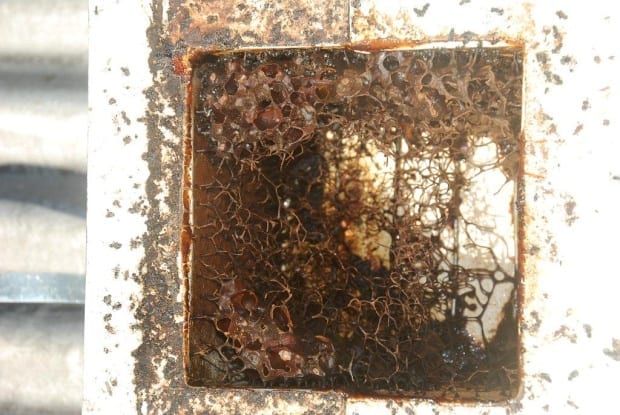
The Apis melifera have made a miscalculation in their swarming plan.
This morning, 15th Febuary 2013, on a cloudy day they swarmed into a nearby avocado tree. Swarms usually range in size from one gallon to four gallons in volume when they have settled. This one was three gallons, so worth boxing. First it was necessary to obtain a frame of brood from an established boxed hive.
The hive I selected would not usually need smoking but due to cloudy and mizzling weather the workers were all home, and none of them were happy. After a few stings on lifting the lid, I fired up the smoker.
First photo (image below) shows the frame of brood suspended under the swarm, bees beginning to cover the brood. Under these circumstances the queen will usually be attracted to the brood. Mizzle has increased to a drizzle.

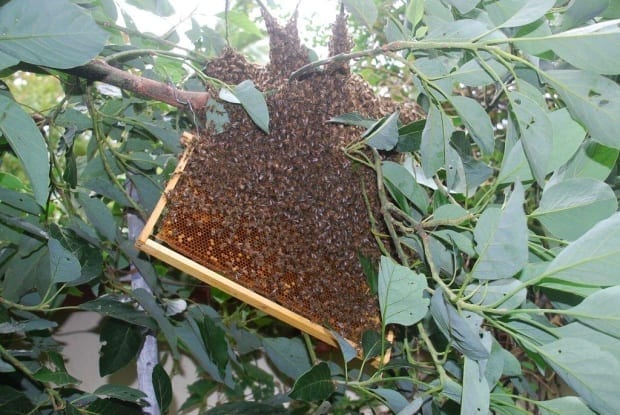
Second photo (image below) shows a box of foundation lifted up under the frame that bees have accepted. Shake branch above box to shake bees onto top of box.

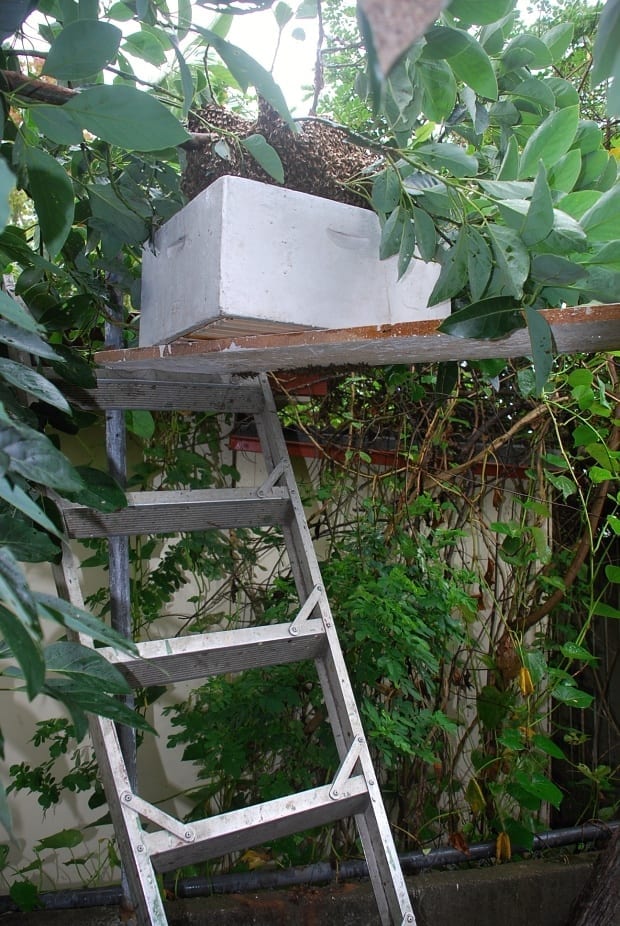
Third photo taken at four o'clock PM, with drizzle increasing to light rain. The lid has been sitting on a couple of sticks so bees can access under lid and also into bottom.

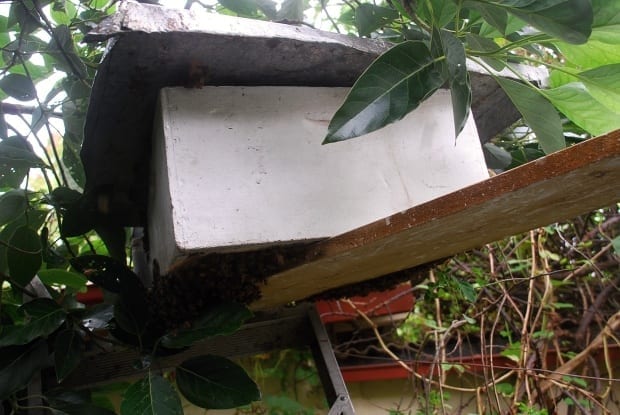
Because three gallons of swarm won't fit into a box of foundation, the excess is seen hanging out of bottom of box. Shift box to a permanent site during light rain and stuff paper in entrance for 24 hours to allow the swarm to settle into their new site, otherwise most will return from whence they came. Identify the hive which has swarmed, which has several capped queen cells in it, and remove two nuke hives.
Now what was this morning a single three story hive is one boxed swarm with the original old queen and three nuke hives. If successful, the three nukes will have new laying queens in two or three weeks.
Bee Hive Wars
This is the season for native bees to attack other hives of native bees, quite often for the purpose of taking over an already established hive, complete with stores of honey and pollen.
Photo 1 (below) shows the entrance of a carbonaria hive which has been under attack for several days. Today the attack seems to be over. It is not possible at this early stage to see if there are new tenants or the remnants of the original inhabitants.

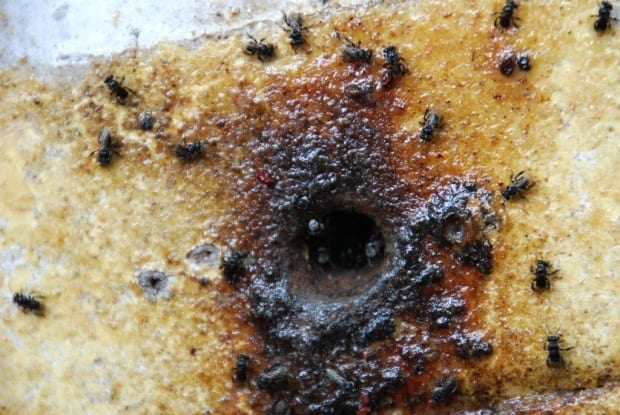
Photo 2 (Below) shows the entrance of a carbonaria hive two metres away from hive 1. To protect themselves this hive built a solid door across their entrance and kept it closed for several days. Today they have opened a small hole in security door and a few bees are venturing out to gather stores. It is a mystery to me why most hives do not seal their entrances when they come under attack, only an odd hive adopt this strategy.

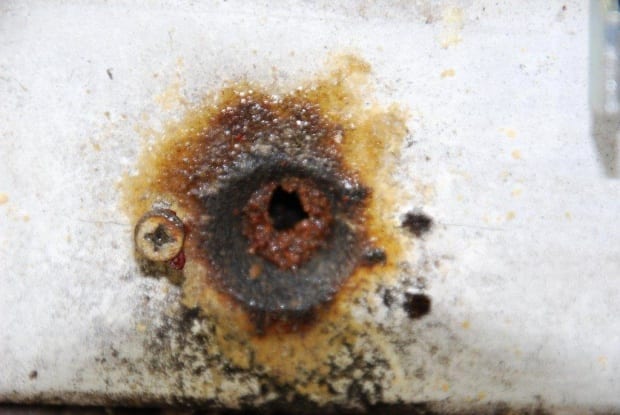
Collecting Native Bee Hive From The Wild
An attempt to educe a new colony of Australian native bees from a log hive
The photo below shows an empty box fitted to a log which contains a colony of Austroplebeia Australis. The bees now have to use an entrance on the far side of the white box to gain entry to their hive in the log. The box is connected to log by the small black pipe, visible in photo.

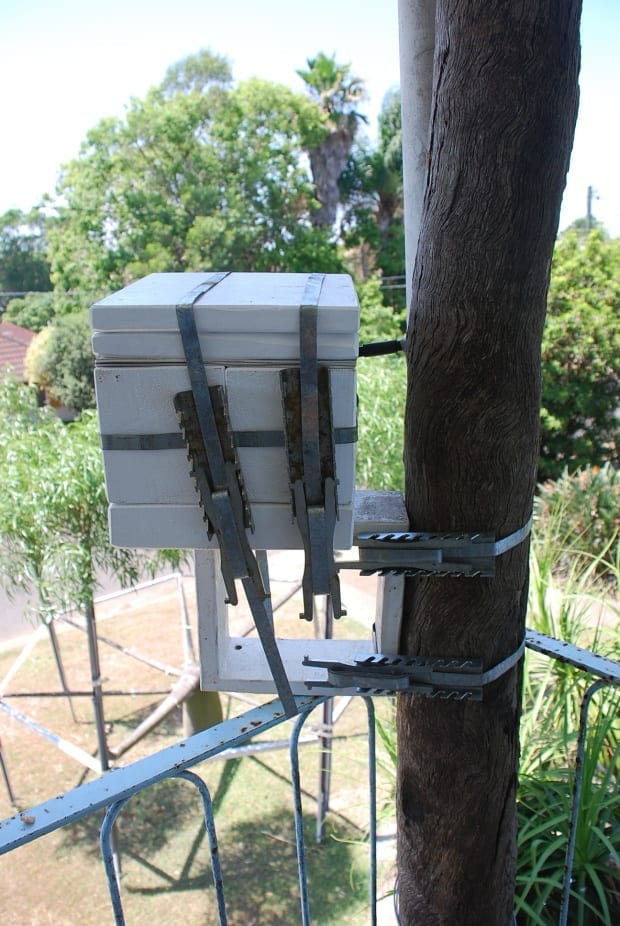
The following photo below, taken two weeks after box was fitted, shows a surprising amount of new build in box. This variety of Australis is the large variety, building honey and pollen pots twice the size of the other variety of Australis. The 5 cent piece visible at top of pollen pots is there for a size reference.

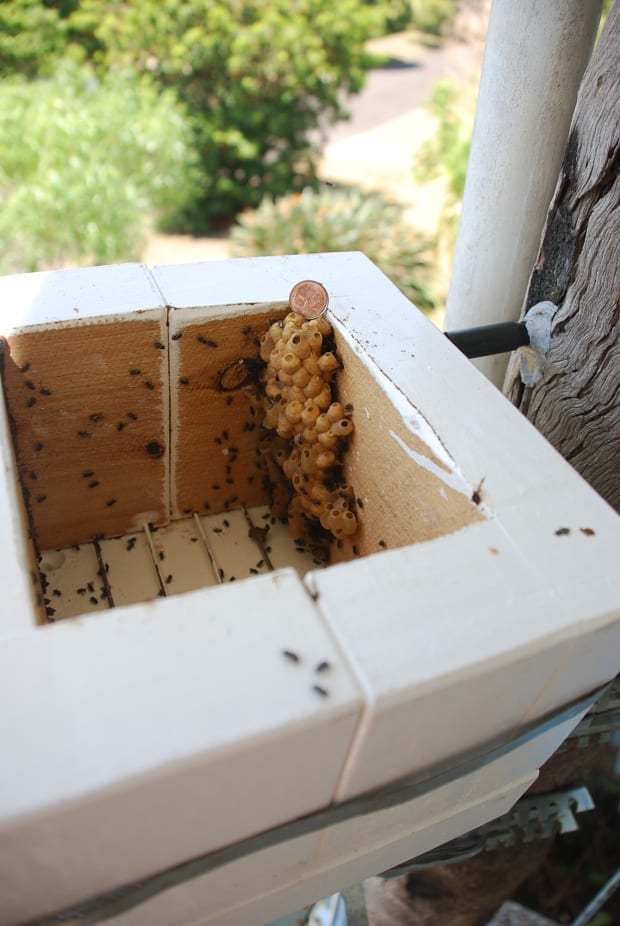
Blue Banded Bees
I haven’t seen iridescent blue banded bees (Amegilla), for two years. This evening, (Christmas Day 2012), after sundown I heard their buzzing in the lower part of a jasmine creeper. After they had settled for the night I took this photo. There were a total of about 130, probably all male, bees.

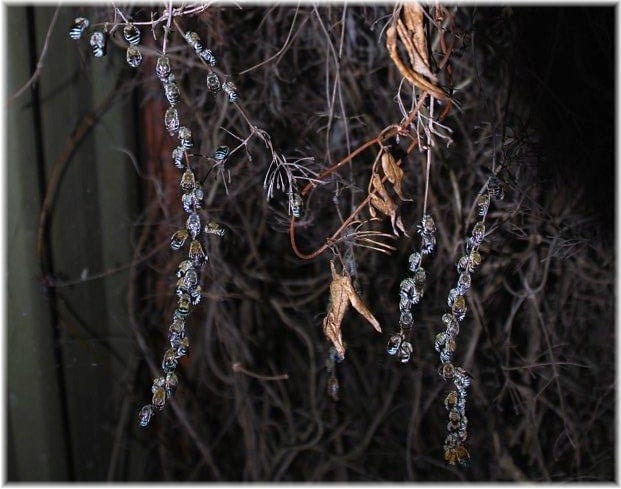
Australian Native Blue Banded Bees grouping together at nightfall
The Symei's – Open Hive Look At Brood

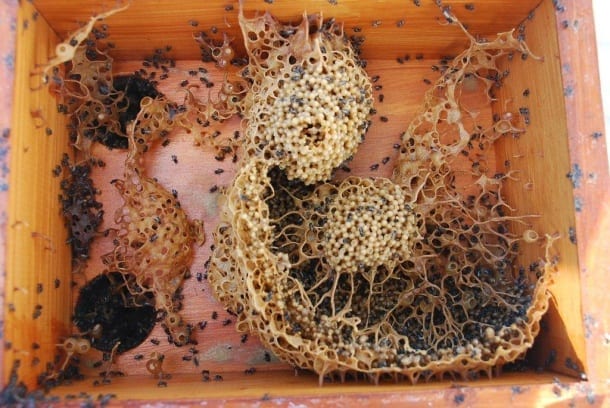
With a warm day today I opened up the Symei to have a look. The hive consists of two boxes high with a separating board between. The entrance to hive is in the lower box where the bees are storing honey and pollen, and the two holes visible at left in photo give bees access to the top box where the queen is at present laying eggs in the round collection of brood cells seen at the upper middle of box.
The larger cresent shaped brood at lower right is the old brood where the bees are now hatching. I'm surprised to see that in winter these Symei have not encased their brood with a skin to help keep their brood warm, as the other varieties which I have do. Perhaps this is because Symei are a North Queensland variety, and used to warmer weather? Australian Natives only use their brood cells once, then dismantle cells and build new cells for the next lot of brood/new bees."
Australian Native Bees – The Symei's

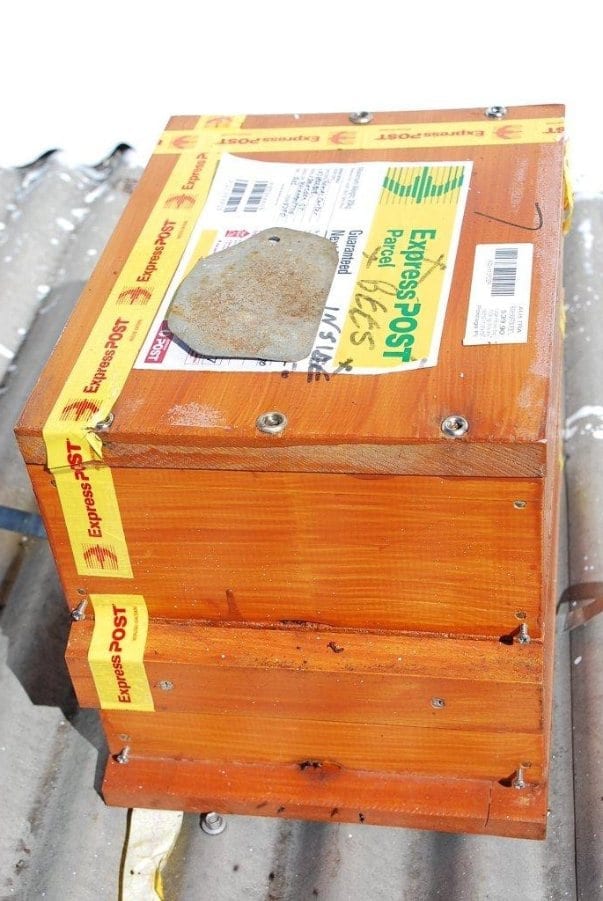
Symei Australian Native Bee Hive – Via Aussie Postal Service (image above)
I was thrilled to receive a phone call recently in response to a call I had made two years ago, in which I enquired after varieties of Australian native bees which I did not have. The Symei's have arrived by post and have settled in well. It is hoped that they will be strong enough to split before Christmas.
Cheers, PC.
Replacement Queen Cells in Beehive (Honey Bee)


Requeening the honey bee hive (Image above)
Its time to requeen the Apis Melitera. When you remove the excisting queen, the workers will make new queen cells out of worker cells. Relacement queen cells are found in the middle of a frame of brood, and swarming queen cells are found at the bottom of the frame.
Australian Native Stingless Bees – “Trigona Carbonaria"


Trigona Carbonaria nest (above) with lid removed, ready to split. By “splitting” a hive in two there is a good chance of the animals making a second nest. A 1 in 5 chance that it won’t work and you will still have one nest, and a small chance that you will end up with no animals. Thats a risk one takes.

Trigona Carbonaria Hive Split in Two (above)
Hive split in two for propagation. Note the honey and pollen stores to the outer, and the brood in the centre. Brood is the young bee nursery.
South African Small Hive Beetle

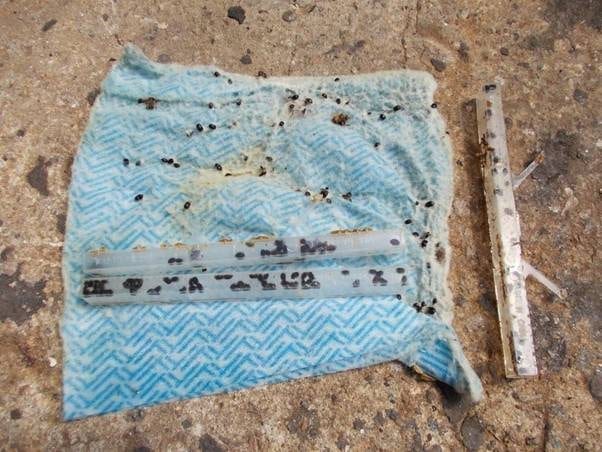
Methods of Beetle control (image above)
The South African Small Hive beetle has been in Australia for about ten years. It is devastating the honey and pollination industries. Seen below are two examples of trapping the beetles within the hive. The clear plastic trap, with small openings only big enough for beetles to enter, has vegetable oil placed in it, then trap is placed between hive frames, giving limited success. The more successful trap is a “chuck wipe”, lain on top of frames. As the bees and beetles shred the synthetic cloth, the beetles find themselves caught in the fine fibres, where they die.
After the beetle has caused the bees to desert their hive, a wasp mimic fly lays its maggots on the comb, making an sad mess of the hive.
Damage to bee hive caused by the wasp mimic fly (image below)

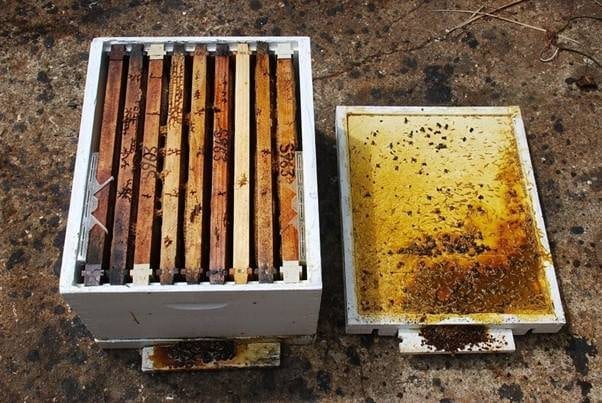
Bee Hive Transfer
A week ago I rescued this hive of European honey bees from an industrial bin. The nest had been in the bin for about a year, starting at the back of the bin.
My aim was to transfer the hive to a standard bee hive box and this is how I did it.

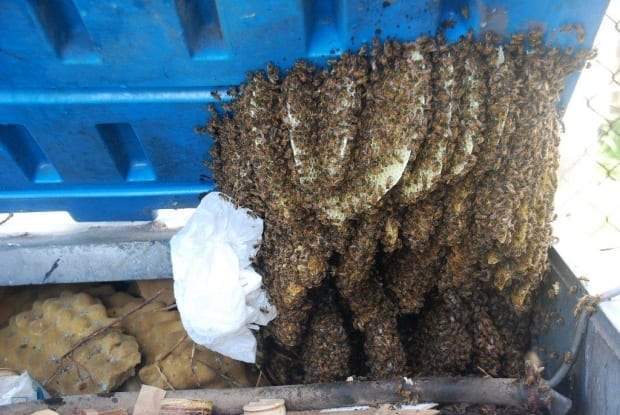
The image (above) shows the lid to the industrial bin lifted with the most recent honey comb fixed to the lid
This next image (below) shows me starting to remove the comb

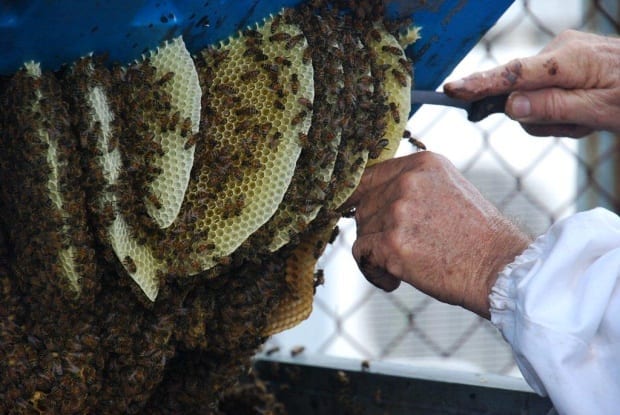
This next stage (image below) is tying brood comb into a standard hive frame for European bees new home

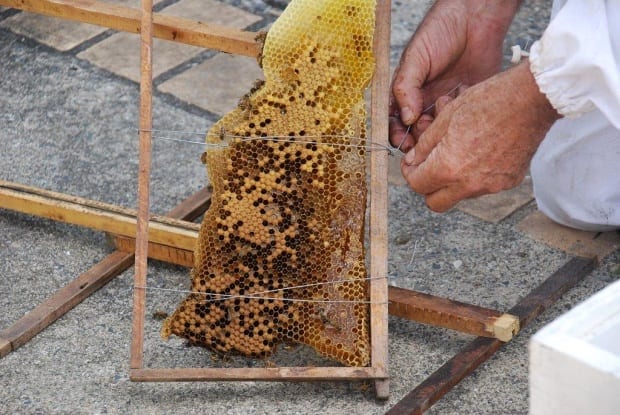
Then, I transferred the new hive box back into the bin to coax the bees into the box and away from the bin lid.
The image below shows the box of framed brood at the rear of the bin

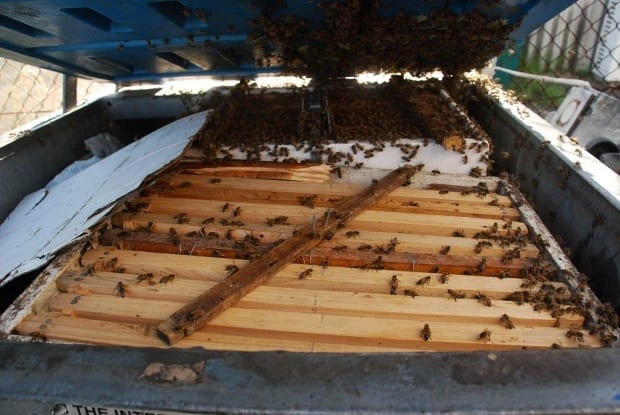
Several days later, I shifted box home. Unfortunately, the next day on opening the hive I found it to be heavily infected with small hive beetles and hundreds of their grubs. Each day I have replaced the bottom board which has many grubs on it, and kill the grubs.
The hive beetle grubs are now becoming less numerous and the queen has started to lay eggs. The hive may or may not survive.
It’s been an interesting way to waste a lot of time.
Cheers, PC.

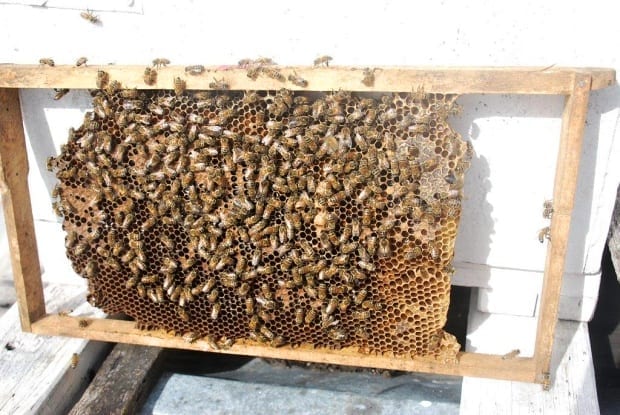
Solitary Native Bees
With the coming of the cooler weather in Queensland, Australia, some of our solitary native b
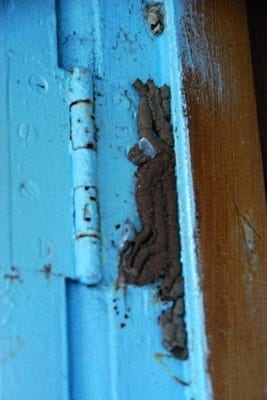
Photo 1 (below) shows a multiple nest of the small yellow bumed resin bee, probably the Firetailed Megachile Mystaceana. The nests appear to be made out of mud, (it may not be mud), similar to some hornets nests. The internal diameter of tubes is about 3 mm.
The nests at the bottom were the hatchings at the beginning of this season, the others will most likely have stores and eggs in them, due to hatch in the coming spring. These nests are located between the door and the door post into our house.
The next photo (below) shows a dead native leafcutter bee. She built a cocoon out of circular pieces she cut out of leaves, then filled it with stores , laid her egg/s, then died.

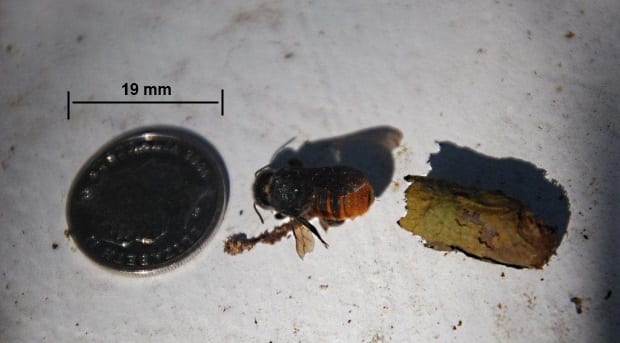
Between her doing this and me taking the recent photo an opportunistic animal came along and had the next generation of leafcutter for dinner! The cocoon is now empty, all that work for nothing! The five cent coin is for a size comparison.
Cheers,
Phantom Comentator.

